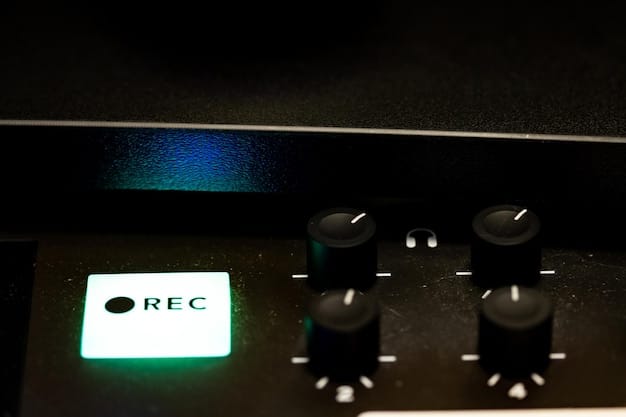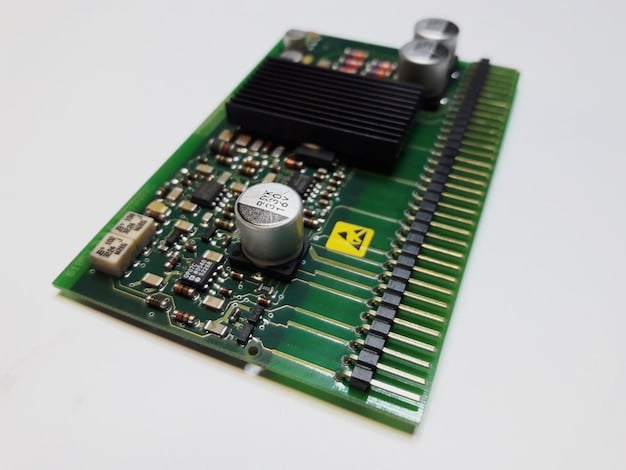Enhance Your PC Gaming Audio: Headphones & Sound Card Guide

Choosing the right headphones and sound card is crucial for immersive PC gaming audio, significantly impacting your experience and providing a competitive edge.
Elevate your PC gaming experience by understanding how the perfect headphones and sound card can provide unparalleled audio immersion. PC Gaming Audio: Choosing the Right Headphones and Sound Card for Immersive Gameplay significantly impacts your ability to react quickly and fully engage with the game’s soundscapes, turning every session into a richer, more competitive experience.
Understanding PC Gaming Audio
The world of PC gaming audio is vast, involving a range of components that work together to produce the sounds you hear. It’s crucial to differentiate what headphones and sound cards do separately, and how they integrate, to enhance your gameplay.
Both headphones and sound cards are integral parts in delivering quality audio, but they serve completely different functions. Let’s explore the purpose and functionality of each component.
The Role of Headphones
Gaming headphones are your direct link to the game’s auditory environment. They convert electrical signals into sound waves, delivering the audio directly to your ears.
- Sound Quality: High-quality headphones accurately reproduce a wide range of frequencies, from deep bass to crisp highs.
- Comfort: Ergonomic design and breathable materials ensure comfort during long gaming sessions.
- Sound Isolation: Closed-back headphones block external noise, while open-back headphones offer a more natural soundstage.
Ultimately, your choice of gaming headphones will enhance depth and realism by accurately capturing everything that the game has to offer sonically.
The Role of Sound Cards
A sound card processes digital audio signals and converts them into analog signals that headphones can use. It’s the backbone of your audio setup, and impacts the overall quality and immersion of your gaming experience.
- Audio Processing: Sound cards add effects, clarify audio, and improve the overall sonic accuracy.
- Connectivity: Provides multiple ports for connecting to different audio devices, like speakers, microphones, and headsets.
- Noise Reduction: Filters out unwanted noise, delivering cleaner and clearer audio.

While onboard audio (integrated into the motherboard) is sufficient for basic usage, a dedicated sound card offers superior processing power and audio fidelity that can dramatically improve your gaming.
Understanding the separate roles of these devices will help you select the appropriate audio components that are best suited for your gaming requirements.
Factors to Consider When Choosing Headphones
When it comes to gaming headphones, the market is flooded with options, each offering a unique set of features. Here are several key factors to consider to make the right choice and improve your overall gaming experience.
Consider the type of headphone that will be best suited for your gaming needs by exploring different types.
Headphone Type: Open-Back vs. Closed-Back
The design of your headphones has a significant impact on how you experience sound. Open-back headphones offer a wide soundstage, creating a more natural and immersive audio environment, while closed-back headphones offer better sound isolation, preventing sound from leaking in or out.
Here’s what each offers:
- Open-Back Headphones: Known for their natural sound and wide soundstage, making them ideal for immersive gaming.
- Closed-Back Headphones: Provide better sound isolation, blocking out external noise and keeping your game audio private.
Your gaming environment and sound preferences will largely influence your choice of headphones.
Sound Quality and Frequency Response
The sound quality of gaming headphones measures the accuracy and clarity of the audio reproduction. A wide frequency response ensures that you hear every detail, from the deepest bass to the highest treble, providing a richer, more immersive experience.
Here are some quick facts to keep in mind:
- Frequency Response: The range of frequencies that the headphones can reproduce; a wider range generally means better sound quality.
- Driver Size: Larger drivers typically produce more powerful and dynamic sound.
- Impedance: Lower impedance headphones are easier to drive and work well with mobile devices, while higher impedance headphones may require an amplifier to reach their full potential.
Paying attention to these details will help you choose headphones that deliver exceptional sound quality and enhance your gameplay.
Comfort and Build Quality
The comfort and durability of your headphones are crucial, especially during long gaming sessions. Look for headphones with cushioned ear cups, an adjustable headband, and a lightweight design.
Build quality is equally important. Headphones should be made from durable materials that can withstand daily wear and tear. Metal frames and reinforced cables are good indicators of a well-built product. Also, consider these aspects:
- Ergonomics: Cushioned ear cups and adjustable headbands provide a comfortable fit.
- Materials: Durable materials like metal and reinforced plastic ensure longevity.
Choosing headphones that are both comfortable and well-built will ensure a pleasurable gaming experience for years to come.
Deciding on comfort and build quality will allow you to enjoy extended sessions for many years.
Understanding Sound Card Specifications
Choosing a sound card involves understanding several key specifications that determine its performance and capabilities. These include the DAC (Digital-to-Analog Converter), sample rate, bit depth, and signal-to-noise ratio (SNR).
Paying attention to specifications like DAC, sample rates, bit depth and SNR will ultimately help you choose a quality soundcard.
DAC (Digital-to-Analog Converter)
The DAC is the sound card’s heart, responsible for converting digital audio data into analog signals that your headphones or speakers can reproduce. A high-quality DAC ensures accurate and detailed sound reproduction, free from distortion and noise.
Consider these advantages of a good DAC:
- Accuracy: A high-quality DAC accurately converts digital data into analog signals, preserving the integrity of the audio.
- Detail: Provides detailed sound reproduction, allowing you to hear every nuance of the game’s audio.
- Clean Sound: Reduces distortion and noise, delivering a cleaner and more enjoyable listening experience.
For serious gamers, a good DAC is essential for obtaining the best sound experience.
Sample Rate and Bit Depth
Sample rate and bit depth are two critical specifications that affect the resolution and quality of your audio. The sample rate determines how many times per second the audio is sampled, while bit depth determines the amount of detail captured in each sample.
They’re typically measured as follows:
- Sample Rate: Measured in kHz (kilohertz), a higher sample rate captures more audio information per second.
- Bit Depth: Measured in bits, a higher bit depth allows for a greater dynamic range and more detailed audio.
Higher numbers generally mean better audio quality, providing a more dynamic and detailed soundstage.

Signal-to-Noise Ratio (SNR)
The signal-to-noise ratio (SNR) measures the strength of the audio signal relative to the background noise. A higher SNR indicates that the audio signal is much stronger than the noise, resulting in clearer and cleaner sound.
SNR is typically measured in decibels (dB), and the higher the number, the better. As a rule of thumb:
- High SNR: Indicates minimal background noise, resulting in cleaner and clearer audio.
- Low SNR: Indicates a higher level of background noise, which degrades the quality of the audio.
For gaming, choosing a sound card with high SNR ensures that you hear every detail without distracting background noise.
Keeping the SNR numbers high reduces background static, so you can experience gaming audio on a more immersive level.
Setting Up Your Gaming Audio
Once you’ve chosen the right headphones and sound card, setting them up correctly is crucial for optimal performance. This involves connecting your devices properly, installing the necessary drivers, and configuring your audio settings.
Once you have your gaming headphones and soundcard, you will need to properly connect them to your PC.
Connecting Headphones and Sound Card
The first step is to physically connect your headphones to your sound card. Most gaming headphones use either a 3.5mm audio jack or a USB connection. If you have a dedicated sound card, plug your headphones directly into the sound card’s headphone output.
These quick tips are helpful to remember:
- 3.5mm Audio Jack: Plug the headphones into the sound card’s headphone output.
- USB Connection: Connect the USB cable to an available USB port on your computer.
When connecting your devices, ensure that the connections are secure and stable to prevent any audio dropouts or interruptions.
Driver Installation and Updates
After connecting your sound card, install the necessary drivers to enable full functionality. Most sound cards come with a driver CD or have drivers available for download on the manufacturer’s website.
Properly maintaining drivers ensures a consistent and quality gaming experience. Keep these tips in mind:
- Install Drivers: Use the provided CD or download the latest drivers from the manufacturer’s website.
- Keep Updated: Regularly check for driver updates as they often include performance improvements and bug fixes.
Keeping your drivers updated ensures that your sound card operates at its best, delivering optimal audio quality and performance.
Configuring Audio Settings
Configuring your audio settings is essential for tailoring the sound to your preferences and gaming needs. Adjust the volume levels, equalizer settings, and surround sound options in your operating system and sound card software.
Here are some details to consider:
- Volume Levels: Adjust the master volume and individual channel levels to achieve the best balance.
- Equalizer Settings: Adjust the equalizer settings to fine-tune the sound to your preferences, boosting or reducing certain frequencies.
- Surround Sound: Enable surround sound options to create a more immersive and realistic audio environment.
Fine-tuning your audio settings ensures that you get the most out of your gaming audio setup, enhancing your overall gaming experience.
Adjusting your volume, equalizer settings and surround sound options will also allow you to have enhanced feedback from in-game elements like gunfire.
Troubleshooting Common Audio Issues
Even with the best equipment, you may encounter audio issues while gaming. Common problems include static noise, low volume, and distorted sound. Troubleshooting these issues can save time and help maintain your competitive edge.
Addressing common issues quickly allow you to return to gaming as quickly as possible.
Identifying the Source of the Problem
The first step in troubleshooting is to identify the source of the problem. Is the issue with your headphones, sound card, or the game itself? Test your headphones with another device to see if the problem persists.
Here’s how to figure it out:
- Headphones: Test with another device to rule out headphone malfunction.
- Sound Card: Try a different sound card or onboard audio to see if the issue resolves.
- Game: Check the game’s audio settings to ensure they are correctly configured.
Isolating the source of the problem will help you focus your troubleshooting efforts and find a solution more quickly.
Solutions for Static Noise and Distortion
Static noise and audio distortion can be caused by various factors, including loose connections, outdated drivers, or interference from other devices. Check all connections to ensure they are secure, and update your sound card drivers to the latest version.
Consider these steps:
- Check Connections: Ensure all cables are securely plugged in.
- Update Drivers: Download and install the latest sound card drivers.
- Reduce Interference: Keep audio cables away from power cords and other sources of interference.
Addressing these common causes can often resolve static noise and distortion issues, restoring clear and clean audio.
Adjusting Volume and Balance
Low volume and unbalanced audio can negatively impact your gaming experience. Check your volume levels in both your operating system and the game’s audio settings to ensure they are properly configured. Make sure that the left and right channels are balanced for even sound distribution.
These checks are important to make:
- System Volume: Adjust the master volume in your operating system.
- Game Settings: Check the game’s audio settings for volume and balance controls.
Properly adjusting the volume and balance ensures that you hear every detail without straining your ears, enhancing your overall gaming experience.
Fixing audio issues allows you to focus on game play with few audio distractions.
Future Trends in Gaming Audio
The future of gaming audio is promising, with technological advancements poised to deliver even more immersive and realistic experiences. Emerging trends include spatial audio, AI-powered audio enhancements, and wireless audio technologies.
Advances like spatial audio and AI-powered enhancements will provide more realism in the years to come.
Spatial Audio Technologies
Spatial audio technologies simulate sound in a three-dimensional space, creating a more realistic and immersive audio environment. These technologies accurately position sounds in relation to the player, enhancing the sense of presence and immersion.
The following are important aspects to consider:
- 3D Sound: Creates a three-dimensional audio environment, enhancing immersion and realism.
- Object-Based Audio: Positions sounds in relation to the player, providing a more accurate and dynamic audio experience.
As spatial audio technologies continue to evolve, they will play a significant role in shaping the future of gaming audio.
AI-Powered Audio Enhancements
Artificial intelligence (AI) is increasingly used to enhance audio quality and performance. AI algorithms can analyze and optimize audio in real-time, reducing noise, improving clarity, and creating more dynamic soundscapes.
Benefits of AI Powered Audio Include:
- Noise Reduction: AI algorithms can filter out unwanted noise and reduce background distractions, creating a cleaner listening environment.
- Dynamic Soundscapes: AI algorithms can adjust the audio in real-time, enhancing the impact of explosions, gunfire, and other sound effects.
AI-powered audio enhancements promise to deliver even more realistic and immersive gaming experiences.
Wireless Audio Technologies
Wireless audio technologies are gaining popularity in the gaming world, offering greater flexibility and convenience. Wireless headphones eliminate the need for cumbersome cables, allowing you to move freely without being tethered to your computer. Wireless audio technologies will improve audio performance for gameplay.
Advantages to wireless audio solutions include:
- Flexibility: Move freely without being tied to your computer.
- Convenience: Easy to set up and use.
As these technologies continue to advance, they will play an increasingly important role in shaping the future of gaming audio.
With audio performance on the rise, wireless solutions are sure to increase in popularity.
| Key Point | Brief Description |
|---|---|
| 🎧 Choosing Headphones | Find headphones that offer comfort and accurate audio reproduction, which will improve gameplay feedback. |
| ⚙️ Sound Card Aspects | Ensure your soundcard has a high SNR for cleaner audio for gameplay. |
| 🛠️ Setup Tips | Update the soundcard drivers to the latest version, and make sure headphones are securely connected. |
| 🔊 Future Trends | Spatial audio and AI enhancements are sure to improve gaming experiences in the future. |
FAQ
div class=”faq-item”>
▼
Open-back headphones offer a wider soundstage, creating a more natural and immersive audio environment, while closed-back headphones provide better sound isolation, blocking out external noise and keeping your game audio private.
▼
A dedicated sound card offers superior processing power and audio fidelity compared to onboard audio. This leads to cleaner audio, more pronounced positional accuracy, and a richer sound experience, which is crucial for competitive gaming.
▼
Sample rate determines how many times per second the audio is sampled; a higher rate captures more detail. Bit depth determines the dynamic range; a higher bit depth allows for more nuanced and detailed audio reproduction.
▼
Ensure all audio cables are securely plugged in, update your sound card drivers to the latest version, and keep audio cables away from power cords and other sources of interference. These steps often resolve static noise issues.
▼
Future trends in gaming audio include spatial audio technologies, which simulate sound in a three-dimensional space, AI-powered audio enhancements, and wireless audio technologies, offering greater flexibility and convenience.
Choosing the right headphones and sound card significantly elevates your PC gaming experience. By understanding the key factors and future trends in gaming audio, you’re equipped to make informed decisions that enhance your gameplay and immersion.





